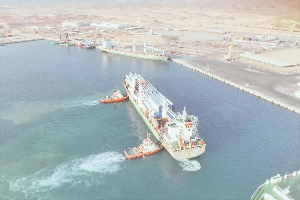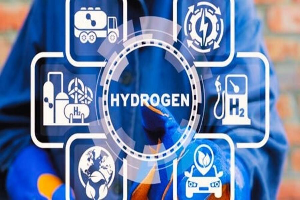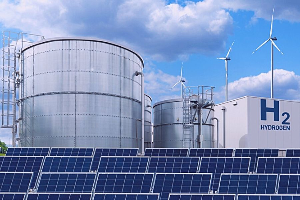Green Hydrogen
The role of green hydrogen in the energy transition is quickly rising up the agenda, with governments and energy companies across the world starting to evaluate the potential advantages of developing the technology to reduce carbon emissions across utilities, transport and industrial sectors.
What is green hydrogen?
Green hydrogen is hydrogen produced by using clean electricity produced from renewable energy technologies to electrolyse water (H20) and separate the hydrogen atom from oxygen.
Why green hydrogen?
Hydrogen is used in oil refining, ammonia and methanol production and steel manufacturing. According to Wood Mackenzie, global demand for hydrogen is 70 million tonnes annually. According to the International Renewable Energy Agency (Irena), more than 95 per cent of hydrogen today is produced from hydrocarbons such as natural gas and coal and is therefore a significant source of carbon dioxide emissions (Co2).
The electrolysers used for green hydrogen production can operate at full capacity in seconds, and, therefore, can be paired with renewable energy assets. This provides a solution to the intermittency problem of renewable energy, and can allow the provision of green electricity at any time of day or night.
Green hydrogen can also be stored for long periods and used for industrial applications and used to power fuel cells for modes of transport such as ships which traditionally produce high volumes of CO2.
Many view the greatest potential for green hydrogen in the aviation, long-haul sea and road transport where there are few alternatives to enable decarbonization.
Grey v blue v green hydrogen
Currently, hydrogen is mainly produced from natural gas, which generates significant carbon emissions. This is known as 'grey hydrogen'.
Blue hydrogen' is a cleaner way of producing hydrogen, where carbon emissions from the hydrogen production process are captured, stored or reused.
'Green hydrogen' is produced by renewable energy resources without creating carbon emissions at all.
What is the cost of green hydrogen?
The main challenge to the implementation of green hydrogen on a large-scale in the short term is the cost. Currently, green hydrogen is significantly more expensive than fossil-fuel hydrogen production.
The cost of green hydrogen today falls between $3 and $7.50 per kilogram (kg), with the cost of conventional 'grey' hydrogen between $0.90-$3.20kg.
The main driver of the cost of 'grey hydrogen' is the price of natural gas.
The cost of green hydrogen is affected by a few different factors. One of these is the cost of the electrolysis, the process through which hydrogen is produced from water. Today, the total electrolysis capacity globally is limited and expensive. However, the planned increases in electrolysis globally is expected to reduce costs of the process substantially in the next decade.
The cost of green hydrogen is expected to fall sharply over the next decade, with the IEA estimating it will drop by 30 per cent by 2030.
Cutting the cost of electrolyzers will be critical to reducing the price of green hydrogen. The IEA believes electrolyzer costs could fall by half by 2040, from around $840 per kilowatt of capacity in 2020.
The most important factor behind the cost of green hydrogen is the price of the clean energy used for the electrolysis process. The cost of generating energy from solar and wind technologies has fallen dramatically since 2010, falling by up to 80 per cent and 60 per cent respectively.
In 2020, Wood Mackenzie released research - Hydrogen production costs to 2040: Is a tipping point on the horizon? that predicted the cost of green hydrogen would fall by 64 per cent by 2040 as the market scales up. The firm believes the costs of green hydrogen will equal fossil-fuel-based hydrogen production by then.
Green hydrogen projects
In August 2020, the Institute for Energy Economics and Financial Analysis (IEEFA) said that it estimated there are 50 green hydrogen projects under development across the world. The projects have a total planned annual production capacity of 4 million tonnes of hydrogen and a total renewable energy capacity of 50GW, according to the IEEFA. The total investment required for all of these projects is $75bn.
According to the IEEFA, 50 projects were at an early stage, with 14 under construction and 34 at the MOU stage.
In July 2020, Saudi Arabia announced its intention to develop a $5bn hydrogen-based ammonia plant in the kingdom. The project will be powered by more than 4GW of renewable energy, and will be able to produce 1.2 million tonnes per year of ammonia, and will have the capacity to produce 650 tonnes of hydrogen daily.
In June 2020, Australian clean energy firm Austrom Hydrogen secured land near Gladstone in Queensland for green hydrogen project which is planned to be powered by a 3.6GW of solar energy.
In April 2020, Perth-based Infinite Blue Energy secured an initial investment of $300m for the first phase of the Arrowsmith Hydrogen project, which will be built in the town of Dongara and produce 25 tonnes of green hydrogen a day using wind and solar energy. Infinite Blue Energy is aiming to have the plant operational by 2022.
Electrolyser manufacturing
The EU has placed Green Hydrogen at the heart of its future energy strategy. The EU has set a 6GW electrolyser target by 2024 in its EU hydrogen strategy. The EU has set a target of producing 1 million tonnes of renewable hydrogen by 2024.
The EU target for electrolyser capacity by 2030 is 40GW.
The EU has estimated that €430bn total investment is required in its green hydrogen sector by 2030 to reach these targets.
In January 2021, Germany’s Linde announced it was planning to build and operate the world’s largest proton exchange membrane (PEM) electrolyser plant for green hydrogen production.
The electrolyser plant will be built at Linde’s Leuna chemical complex in Germany. The 24MW electrolyser will produce green hydrogen for Linde’s industrial customers through Linde’s existing pipe network.
Linde will also sell liquefied green hydrogen to refuelling stations and other industrial customers in the region.
The largest electrolyser in operation today is a 10MW facility in Japan.
The electrolyser will be built by ITM Linde Electrolysis, a joint venture between Linde and ITM Power. The green hydrogen plant is scheduled to begin production in the second half of 2022.
In January 2021, Siemens Energy and Siemens Gamesa announced they were planning to invest in a programme to develop an industrial-scale system capable of garnering green hydrogen from offshore wind turbines.
The firms are targeting investment of EUR120m over the next five years to assist development of a solution that integrates an electrolyser into an offshore wind turbine to directly produce green hydrogen.
The companies are planning to have developed a full-scale offshore demonstration of the technology by 2025/26.
Siemens Gamesa will invest EUR80m in the project, with Siemens Energy providing EUR40m in the venture. The project will involve the adaptation of Siemens Gamesa’s SG14-222DD offshore wind turbine to integrate an electrolysis system into the turbine’s operations.
Green hydrogen can become the 'oil of the new era'
In an exclusive interview with Energy & Utilities, Manuel Kuehn, Head of New Energy for Middle East and Africa, Siemens Energy, discusses the reasons why green hydrogen can become the oil of the new era and be the game changer for the energy transition.
The role of green hydrogen in the energy transition is quickly rising up the agenda, with governments and energy companies across the world starting to evaluate the potential advantages of developing the technology to reduce carbon emissions across utilities, transport and industrial sectors.
The role of green hydrogen in the Middle East’s energy transition was recently brought into sharp focus when it was announced that initial agreements had been signed to develop a $5bn green hydrogen ammonia production facility in the $500bn Neom development in Saudi Arabia. In the UAE, Germany’s Siemens is working with Dubai Electricity & Water Authority (Dewa) on the region’s first green hydrogen pilot scheme.
Energy & Utilities caught up with Manuel Kuehn, Head of New Energy for Middle East and Africa, Siemens Energy, to find out more about the opportunities and challenges in integrating green hydrogen into energy transition programmes across the region.
Middle East prepares for Green hydrogen revolution
Green hydrogen is rapidly becoming a focal point of the energy transition discussion in many areas of the world, and the Middle East and North Africa (Mena) is no exception as governments seek to diversify their energy sectors and economies. Energy & Utilities delves into the potential for green hydrogen in the region and what needs to be done to turn plans into reality.
Green hydrogen is rapidly becoming a focal point of the energy transition discussion in many areas of the world, and the Middle East and North Africa (Mena) is no exception as governments seek to diversify their energy sectors and economies.
The potential for green hydrogen in the region was given stark focus in July when it was announced that US-based Air Products and the local Acwa Power had signed a memorandum of understanding (MoU) to develop a $5bn hydrogen-based ammonia plant in Saudi Arabia.
The $5bn hydrogen-based plant will be located at the planned $500bn Neom development on the Red Sea Coast of the kingdom, one of the kingdom’s Public Investment Fund (PIF’s) key megaprojects planned to diversify the country’s economy away from a dependence on oil.










